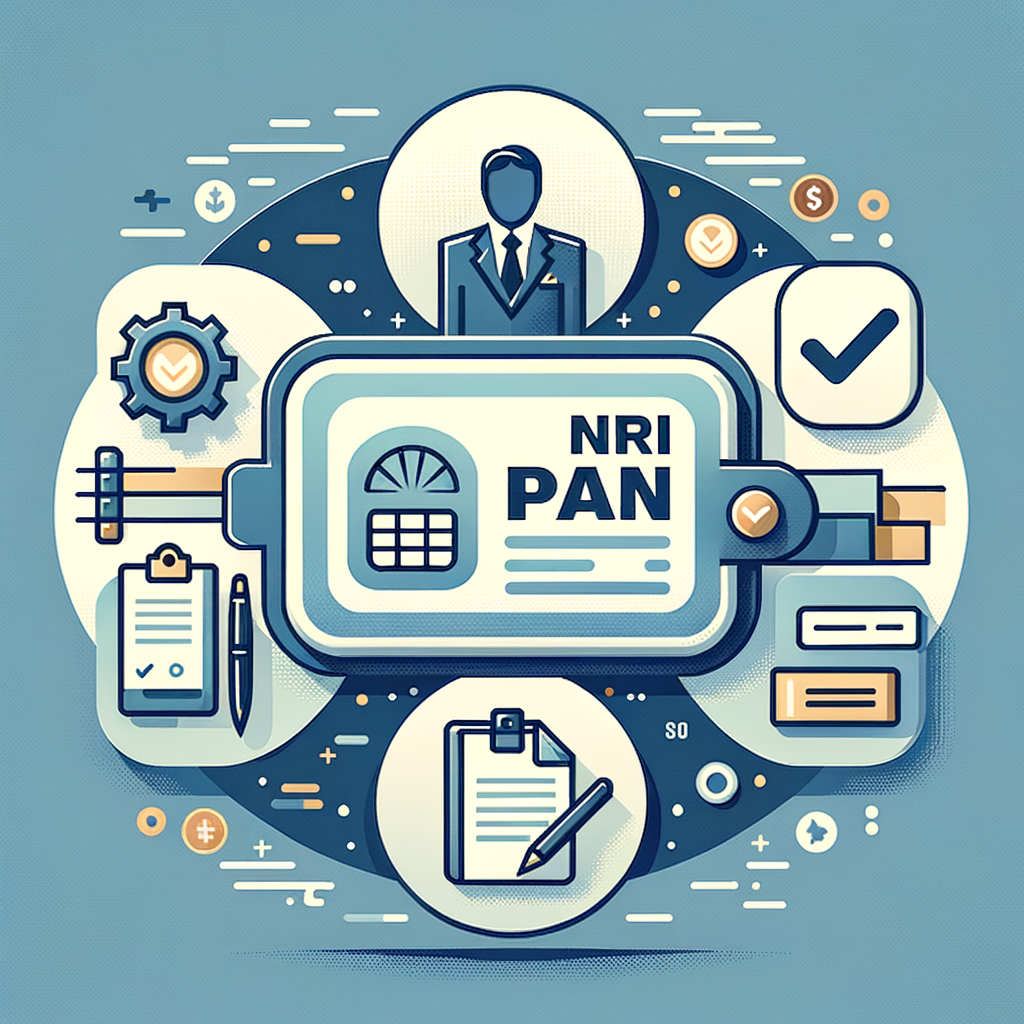What is the process for obtaining an NRI PAN card? A Step-by-Step Guide for 2024
Navigating financial responsibilities in India while living abroad can seem complex, but one document stands as the cornerstone for almost every transaction: the PAN (Permanent Account Number). This ten-digit alphanumeric code is just as vital for a Non-Resident Indian (NRI) as it is for a resident. If you’re an NRI looking to invest, buy property, or manage your income in India, understanding the NRI PAN card application process is the first essential step. This comprehensive guide will walk you through every stage, from checking your eligibility and gathering documents to submitting your application online, ensuring you can manage your financial life in India seamlessly. The importance of an NRI PAN card cannot be overstated, as it is the key to unlocking hassle-free financial management and compliance from anywhere in the world.
Why is a PAN Card Essential for an NRI?
Many NRIs wonder if they truly need a PAN card, especially if they spend most of their time outside India. The answer is a resounding yes. The Income Tax Department mandates a PAN for a wide array of financial activities, and not having one can lead to significant hurdles and financial disadvantages. It’s more than just a tax number; it’s your financial passport within the Indian economic system, ensuring your transactions are transparent, legitimate, and correctly taxed. For an NRI with financial roots or future investment plans in India, a PAN card is an indispensable tool for smooth and compliant operations.
Here are the primary reasons why obtaining a PAN card is crucial for any NRI:
- Mandatory for Investments: If you plan to invest in the Indian market, whether in mutual funds, stocks, bonds, or other securities through platforms like the Portfolio Investment Scheme (PIS), a PAN card is a non-negotiable prerequisite. It links all your investments to a single identification number, making tracking and taxation straightforward for regulatory bodies like SEBI and the RBI.
- Property Transactions: Buying or selling any immovable property in India valued above a certain threshold requires quoting your PAN. Without it, you cannot legally register the property in your name, effectively halting any real estate ambitions you might have.
- Filing Income Tax Returns (ITR): If you earn any taxable income from sources within India—such as rental income from property, capital gains from selling assets, or interest from certain bank deposits—you are required to file an ITR. A PAN is mandatory to file these returns and stay compliant with Indian tax laws.
- Banking Operations: While you can open an NRE (Non-Resident External) or NRO (Non-Resident Ordinary) account without a PAN initially, banks will insist you furnish one within a stipulated period. A PAN is essential for high-value transactions, fixed deposits, and the overall smooth operation of your Indian bank accounts.
- Avoiding High TDS: This is one of the most significant financial benefits. If you have Indian income on which Tax is Deducted at Source (TDS), not having a PAN card results in TDS being deducted at a much higher rate (often 20% or more, as per the rules). With a PAN, the TDS is deducted at the normal, lower rates applicable to your income slab, saving you a substantial amount of money upfront.
- Proof of Identity: A PAN card is a nationally accepted, government-issued proof of identity. It is a reliable and recognized document that can be used for various verification purposes across the country.
Eligibility for an NRI PAN Card in India
Before diving into the application, it’s vital to understand who is eligible. The eligibility for an NRI PAN card India is straightforward and primarily depends on your citizenship and residential status. The term ‘NRI’ itself has a specific definition under Indian law, and there are different application forms based on whether you are an Indian citizen living abroad or a person of foreign origin with ties to India. Understanding this distinction is the first step toward a successful application.
Who is considered an NRI?
According to the Indian Income Tax Act, 1961, you are considered a Non-Resident Indian (NRI) for a financial year if you are an Indian citizen who has not resided in India for 182 days or more during that year. Essentially, if you are an Indian citizen with an Indian passport but live and work abroad for more than half the year, you qualify as an NRI.
It’s also important to note that individuals who are not Indian citizens can also apply for a PAN card if they have financial dealings in India. This includes:
- Persons of Indian Origin (PIO): Individuals whose ancestors were Indian nationals but who now hold foreign citizenship.
- Overseas Citizens of India (OCI): A special status granted to foreign citizens of Indian origin, allowing them most rights of an Indian citizen except for voting and holding public office.
Any NRI PAN card for Indian citizens abroad is not just a possibility but a necessity for anyone maintaining financial connections with the country. The key is to select the correct application form that corresponds to your specific citizenship status.
The Complete NRI PAN Card Application Process: A Step-by-Step Guide
The NRI PAN card application process has been streamlined over the years and can be completed almost entirely online. By following these steps carefully, you can ensure your application is processed without any delays or rejections. Let’s break down the journey from identifying the right form to receiving your physical PAN card at your foreign address.
Step 1: Identify the Correct Application Form (Form 49A vs. Form 49AA)
This initial step is the most critical, as selecting the wrong form will lead to immediate rejection of your application. The choice of form depends entirely on your citizenship status, not your residential status. It is a common point of confusion, so pay close attention to which form applies to you. The two forms are designed for different categories of applicants and require distinct documentation and verification processes.
| Form Number | Who Should Use It? | Key Identifier |
|---|---|---|
|
Form 49A |
Indian citizens, including NRIs who hold an Indian passport. |
You are a citizen of India, regardless of where you currently live. |
|
Form 49AA |
Foreign citizens, including PIOs and OCIs. |
You hold a passport from a country other than India. |
Actionable Tip: Before you begin the NRI PAN card online application in India, double-check your citizenship status. If you hold an Indian passport, you must use Form 49A. If you hold a foreign passport (e.g., American, British, Australian), even if you have an OCI or PIO card, you must use Form 49AA.
Step 2: Compile the NRI PAN Card Requirements India
Having all your documents ready before you start the online application will save you time and prevent errors. The NRI PAN card requirements India are specific, and all submitted copies must be self-attested (signed by you). Ensure your documents are clear, valid, and match the details you will enter in the application form.
Here is a comprehensive list of documents you will need:
For Proof of Identity (any one):
- Passport: This is the most common and recommended proof of identity for NRIs.
- OCI Card: For Overseas Citizens of India.
- PIO Card: For Persons of Indian Origin.
For Proof of Address (any one):
- Passport: The address page of your passport can be used.
- Foreign Bank Account Statement: A copy of your bank account statement in your country of residence (must not be more than three months old).
- NRE Bank Account Statement in India: This must be less than six months old and clearly show your overseas address.
- Visa or Resident Permit: A copy of your visa or the resident permit issued by the country where you reside.
For Proof of Date of Birth (any one):
- Passport: The information page of your passport clearly stating your date of birth.
- Birth Certificate: A copy of your official birth certificate.
- Driving License: A copy of your driving license from your country of residence.
Photographs:
- Two recent, colour, passport-sized photographs (size 3.5 cm x 2.5 cm). The background should be plain and light-coloured.
Pro Tip: Ensure your signature on the self-attested documents and the application form is consistent. Any mismatch can lead to queries and delays in processing.
Step 3: The NRI PAN Card Online Application in India
Once your documents are ready, you can proceed with the NRI PAN card online application in India. The process is handled by two government-authorized agencies: NSDL e-Governance Infrastructure Limited and UTI Infrastructure Technology and Services Limited (UTIITSL). The procedure on both portals is very similar.
- Visit the Official Portal: Go to either the NSDL TIN website or the UTIITSL Portal.
- Fill the Form:
- On the homepage, select ‘Apply Online’.
- Application Type: Choose ‘New PAN – Indian Citizen (Form 49A)’ or ‘New PAN – Foreign Citizen (Form 49AA)’ based on your citizenship.
- Category: Select ‘Individual’.
- Personal Details: Fill in your name, date of birth, email, and mobile number. Be extremely careful to enter your name exactly as it appears on your identity proof (passport).
- Communication Address: This is a crucial step. You must select your foreign address as the ‘Address for Communication’. Your physical PAN card will be mailed to this address.
- AO (Assessing Officer) Code: You need to provide the AO code relevant to your jurisdiction. The portals have built-in tools to help you find your AO code based on your city or income source.
- Document Submission Option: You will be given a choice to submit documents. For most NRIs, the most reliable method is to forward the documents physically after completing the online payment. While e-Sign/e-KYC options exist, they are often linked to Aadhaar, which may not be applicable or available to NRIs.
Step 4: Pay the NRI PAN Card Application Fees in India
The application fee depends on whether your communication address is within India or outside India. Since NRIs must provide a foreign address, the international dispatch fee will apply.
Here’s a breakdown of the typical NRI PAN card application fees India:
- For Communication Address Outside India: The fee is approximately ₹1,020. This includes the application fee and charges for dispatching the physical PAN card to your foreign address via courier.
- For Communication Address Within India: The fee is approximately ₹107. This is applicable only if you have a representative or address in India where you can receive the card.
Note: These fees are subject to change and may have additional GST. Always verify the final amount on the NSDL or UTIITSL portal during payment. You can pay using a credit card, debit card, net banking, or by sending a Demand Draft.
Step 5: Submit Documents and Track Your Application
After successful payment, the final step is to courier your documents to the processing agency. This is a vital part of completing the steps to apply for an NRI PAN card.
Physical Submission Process:
- Print Acknowledgment: After payment, an acknowledgment form with a 15-digit acknowledgment number will be generated. Print this form.
- Affix Photographs: Paste your two recent passport-sized photographs in the designated spaces on the form. Do not staple or pin them.
- Sign the Form: Sign within the box provided. Make sure your signature does not run over the photograph on the left. A second signature is required at the bottom of the form.
- Mail the Documents: Put the signed acknowledgment form and all your self-attested document copies in an envelope. Superscribe the envelope with ‘APPLICATION FOR PAN – <Your 15-digit Acknowledgment Number>’. Mail it to the NSDL or UTIITSL address provided on the acknowledgment receipt (usually their office in Pune or Mumbai).
Tracking Your Application:
The 15-digit acknowledgment number is your key to tracking the status of your application. You can visit the tracking page on the NSDL portal or the UTIITSL portal and enter this number to see the current status, from receipt of documents to dispatch of your PAN card.
Common Mistakes to Avoid in Your NRI PAN Application
Even a minor mistake can delay your application or lead to its rejection. By being aware of common pitfalls, you can ensure a smooth process. Here are some frequent errors to watch out for:
- Using Form 49A instead of Form 49AA (or vice-versa): This is the most common error. Remember, Form 49A is for Indian citizens, and Form 49AA is for foreign citizens.
- Mismatch in Name or Date of Birth: Your name, father’s name, and date of birth on the application form must match your supporting documents (especially your passport) perfectly, down to the spelling and initials.
- Providing an Indian Address for Communication: While it might seem convenient, an NRI should provide their foreign address for communication to establish their non-resident status clearly.
- Forgetting to Self-Attest Document Copies: Every single document copy you submit must be signed by you. Unattested documents will not be accepted.
- Incorrect Photograph Size or Signature: Use the specified photograph size (3.5 cm x 2.5 cm) and ensure your signature is clear and within the designated box on the acknowledgment form.
Conclusion
While it involves several steps, the NRI PAN card application process is a logical and manageable task when approached with care. By choosing the correct form, meticulously preparing your documents, and accurately filling out the online application, you can secure this vital financial tool without any trouble. For any NRI with existing or future financial interests in India, a PAN card is not optional—it is the foundation for investment, property ownership, and tax compliance. It simplifies transactions, reduces tax liability, and legitimizes your financial presence in the country.
Feeling overwhelmed by the paperwork? The steps to apply for an NRI PAN card can be tricky to navigate alone. Let TaxRobo’s experts handle the entire process for you, ensuring a fast, accurate, and hassle-free application. Contact Us Today for a Free Consultation!
Frequently Asked Questions (FAQs)
Q1: How long does the NRI PAN card application process take?
A: It typically takes 15-25 working days from the date the processing agency (NSDL/UTIITSL) receives your complete and correct documents. The e-PAN card is often generated and emailed to you within a week, while the physical card takes longer due to international shipping.
Q2: Can I get my PAN card delivered to my foreign address?
A: Yes, absolutely. You must provide your foreign address as the ‘Address for Communication’ during the application. The physical PAN card will be dispatched to that address. The application fee is higher to cover international courier charges.
Q3: Is Aadhaar mandatory for an NRI to apply for a PAN card?
A: No, Aadhaar is not mandatory for Non-Resident Indians as per the current income tax rules. You can successfully apply for a PAN card using your passport as the primary proof of identity and address.
Q4: I am an Indian citizen currently working in Dubai. Which form should I use?
A: As an Indian citizen living abroad, you are an NRI. You should use Form 49A for your NRI PAN card online application in India. Form 49AA is meant for foreign citizens only.
Q5: What happens if I don’t have a PAN card as an NRI?
A: You will be unable to make high-value investments, purchase property, or open certain types of bank accounts in India. Furthermore, any income you earn in India (like rent or interest) will be subject to Tax Deducted at Source (TDS) at the highest applicable slab, which is often much higher than the normal rate, leading to a significant loss of funds.




Really enjoyed this article, is there any way I can get an update sent in an email every time you make a new article?
I was suggested this blog by my cousin. I am not sure whether this post is written by him as nobody else know such detailed about my difficulty. You are amazing! Thanks!
Howdy just wanted to give you a quick heads up and let you know a few of the images aren’t loading correctly. I’m not sure why but I think its a linking issue. I’ve tried it in two different browsers and both show the same outcome.
Thanks for the sensible critique. Me & my neighbor were just preparing to do some research on this. We got a grab a book from our local library but I think I learned more from this post. I am very glad to see such wonderful information being shared freely out there.